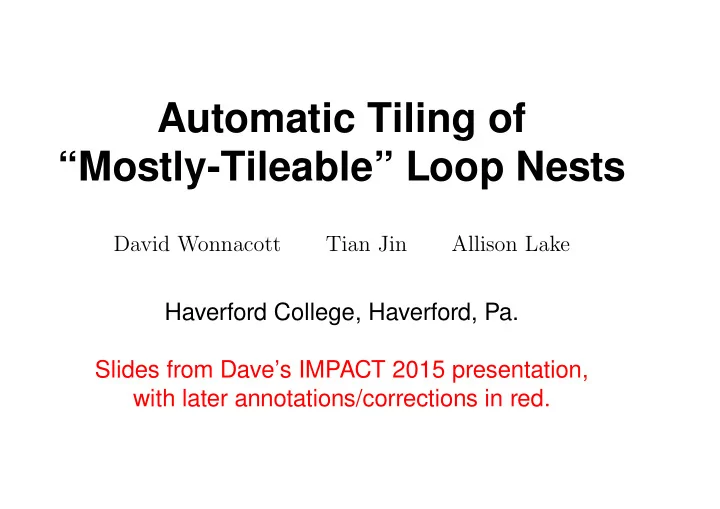

Automatic Tiling of “Mostly-Tileable” Loop Nests David Wonnacott Tian Jin Allison Lake Haverford College, Haverford, Pa. Slides from Dave’s IMPACT 2015 presentation, with later annotations/corrections in red.
Loop Tiling [a.k.a. Blocking, Supernode Partitioning] Idea � n � n � � Treat n ∗ n iteration space as tiles of size b ∗ b • ∗ b b Purpose: Optimization Improve locality on uniprocessors • Transfer blocks, reduce false sharing on multicore • Legality (classical conditions): “Fully permutable” loop nest, i.e., • All elements of all dependence vectors are � 0 • (May be enabled by prior loop transformation) •
Are Reductions “Permutable”? What are the dependences of this loop? sums(i) = 0 for j = 0,size-1 do sums(i) = sums(i) + A(i,j) endfor The Omega Project’s “petit” analysis tool says: anti 6: sums(i) --> 6: sums(i) (+) flow 6: sums(i) --> 6: sums(i) (+) output 6: sums(i) --> 6: sums(i) (+) “petit -r”: 6: sums(i) --> 6: sums(i) (+) reduce Maybe this? reduce 6: sums(i) --> 6: sums(i) ( * )
A Challenging Program with Reductions Nussinov’s algorithm (RNA secondary structure prediction) N ( i, j ) = max ( N ( i + 1 , j − 1) + δ ( i, j ) , max i � k<j ( N ( i, k ) + N ( k + 1 , j ))) (i.e., maximize number of base-pair matches.) In code: ! N initially all 0 for i = size-1,0,-1 do for j = i+1,size-1 do for k = i,j-1 do N(i,j) = max(N(i,j), N(i,k)+N(k+1,j)) endfor if j-1 >= 0 and i+1 < size and i < j-1 then N(i,j) = max(N(i,j), N(i+1,j-1)+match(seq[i], seq[j])) endif endfor endfor
Tiling Nussinov’s Algorithm Dependences (from petit -r, reductions as * not +): reduce 19: N(i,j) --> 22: N(i,j) (0,0) reduce 19: N(i,j) --> 19: N(i,j) (0,0, * ) flow 19: N(i,j) --> 19: N(i,k) (0,+,*) // (0,+,+) flow 19: N(i,j) --> 19: N(k+1,j) (+,0,*) flow 19: N(i,j) --> 22: N(i+1,j-1) (-1#,1) flow 22: N(i,j) --> 19: N(i,k) (0,+) flow 22: N(i,j) --> 19: N(k+1,j) (+,0) flow 22: N(i,j) --> 22: N(i+1,j-1) (-1#,1) So, is this tileable? ? No (or, only i/j), since (0,0,*) is not all � 0 • ? Yes, since (0,0,*) should be (0,0,+) for δ,δ − ,δ o note: • (+,0,*) also blocks tiling; the dep marked (0,+,*) by petit is actually (0,+,+). ? “Mostly”, as we shall see... •
Tiling Nussinov’s Algorithm Well So, is this tileable? ? No (or, only i/j), since (0,0,*) is not all � 0 • correct code, but could be faster... − ? Yes, since (0,0,*) should be (0,0,+) for δ, δ − , δ o • incorrect code produced by classical tiling − due to the (+, 0, *) flow dependence ? “Mostly”? What do I mean by “mostly-tileable”? • asymptotically small number of problematic − dependences (grow w/tile size, not problem)
Mostly-Tileable Loops of Nussinov’s Algorithm Tiling only the i/j nest works fine, as noted before.
Mostly-Tileable Loops of Nussinov’s Algorithm If we group updates from consecutive k, some are o.k.
Mostly-Tileable Loops of Nussinov’s Algorithm However, some read unfinished elements of updating tile...
Mostly-Tileable Loops of Nussinov’s Algorithm ... for any order of the k-loop’s tiles.
Mostly-Tileable Loops of Nussinov’s Algorithm ... for any order of the k-loop’s tiles. :-(
Tiling Mosty-Tileable Loop Nests Recall that some updates were fine: As problem size grows, these outnumber problems, so: Tile loop nest ignoring the reduction • “Peel” problematic iterations of k (index-set splitting) • Execute • tiled non-problematic iterations − then peeled iterations −
How Best to Generalize This What should we ignore to find mostly-tileable nests? Just (all) reductions? actually, these aren’t the problem • Identify direction of reductions as in [GR06]? • Ignore some other “problematic” dependences? • Current plan: check all not-fully-tileable nests to see if • O (card(problem iterations)) <O (card(non-problem iterations)) Best choice may depend on which problems can benefit... So, what other problems look interesting? Other dynamic programming (e.g., bioinformatics) • Note: some is fully tileable without peeling − Circular-Stencils? Yes? No? Still thinking.... • Your thoughts? •
Recommend
More recommend